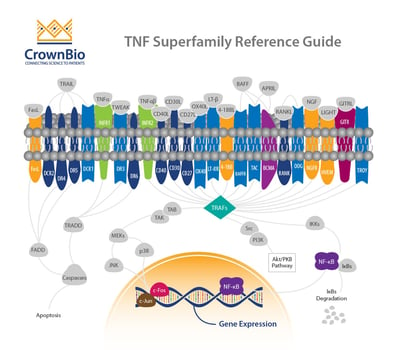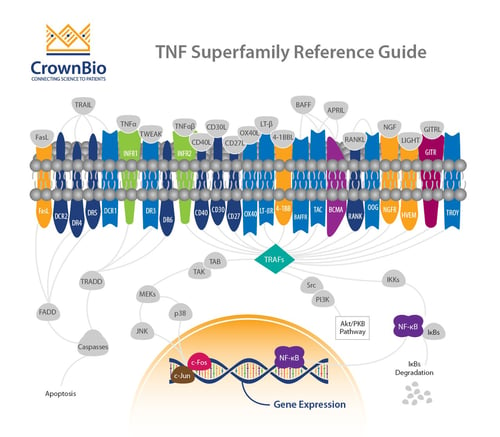Tumor Necrosis Factor Superfamily of Ligands and Receptors 101

 Members of the large Tumor Necrosis Factor (TNF) superfamily (TNFSF) of proteins participate in the coordinated function of a multitude of both innate and adaptive immune cells. These proteins play a role in the entire life-cycle of immune cells - differentiation, activation, inhibition, and even death. This means that many of the family members are coming into play as immuno-oncology targets, and we’ll look more at different ligands and receptors from this family in detail in subsequent blogs.
Members of the large Tumor Necrosis Factor (TNF) superfamily (TNFSF) of proteins participate in the coordinated function of a multitude of both innate and adaptive immune cells. These proteins play a role in the entire life-cycle of immune cells - differentiation, activation, inhibition, and even death. This means that many of the family members are coming into play as immuno-oncology targets, and we’ll look more at different ligands and receptors from this family in detail in subsequent blogs.
The namesake of this superfamily has already proved to be fertile ground for drug development with several marketed anti-inflammatory agents directed specifically against TNF-α. Familiar names such as Remicade®, Simponi®, and Humira® (antibodies against TNF-α), Cimzia® (PEGylated Fab fragment against TNF-α), and Enbrel® (TNF receptor 2/Fc Fusion protein), have all been successful drugs for a wide variety of diseases. Other TNFSF targeted agents include Benlysta® (antibody to BAFF) and Prolia®/Xgeva® (antibody to RANKL).
TNF Superfamily Basics: Membrane Bound Ligands and Three Receptor Types
The ligands are typically membrane bound, although some can signal as soluble species as well. The ligands also self-assemble into non-covalent trimeric complexes. The fact that they are found mostly as membrane bound complexes is evidence to their key role in cell-cell interactions.
The receptors of this family can be divided into 3 distinct groups, depending upon their signaling machinery:
- The first group signals through a so-called death domain typically inducing apoptosis in this context.
- The second group signals through the TNFR associated factors, or TRAFs. Depending on the receptor/ligand pair and the associated TRAFs, downstream activation of NF-κB, JNK, Erk, Akt can occur. Clearly the signaling in this family is very complex.
- Finally, the third group of receptors are not competent for signaling and act as decoy receptors.
Of interest is the observation that one of the decoy receptors (Dcr3) has been observed to be amplified in a subset of lung and colon cancers as a way for these cancer cells to escape ligand induced cell death.
Many Functions including Coordinating Inflammatory and Immune Responses
While it is appreciated that this large family of ligands and receptors is involved in many biological processes, including bone and skin development, these proteins are best known for their diverse roles in coordinating inflammatory and immune responses. As is evident from the above mentioned list of approved drugs targeting this family, inflammation and autoimmunity is the focus and a key function for these molecules.
For productive activation of a T cell, the cell must recognize its target, through engagement of antigen and the T cell receptor. The T cell must also receive co-stimulatory signal(s) in parallel. These signals are generated through the interactions of TNF superfamily ligands and receptors (TNFRSF).
Multiple Interactions Needed for a Full Immune Response
Of course a multitude of these interactions make up the complex dance among many different cell types involved in an immune response – T cells, B cells, dendritic cells, neutrophils, macrophages, and other parenchymal and stromal cells such as epithelium and fibroblasts or endothelial cells. Recognizing that the ligands are mostly cell surface bound, this increases the bar on this complexity.
The interaction between two (or more) cells can bring together several members of the TNFSF and TNFRSF, and that in this sense each of the “dance” partners can activate (or inhibit) each other reciprocally. The complexity generated by so many different cell types interacting through so many different ligands and receptors resembles less a waltz around the ballroom and more of a stage dive into the mosh pit.
The Future – Family Members Leveraged for Immuno-Oncology
Complexity aside, knowing more about each of these proteins has led to considerable effort aimed at modulating the signaling from each of these receptors – the goal in this case is to potentially help the T cell along by providing exogenous co-stimulatory signals.
We will continue this series in the coming weeks with a look into how individual members of this superfamily, such as CD137, OX40, and GITR (to name just a few), are being leveraged in the dynamic area of immuno-oncology.


